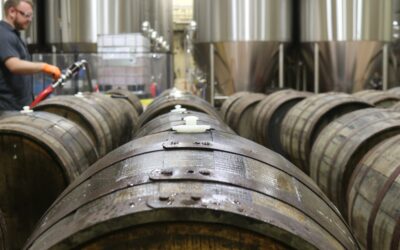The current popularity of ‘sour’ and ‘wild’ beers, many containing fruit flavourings, is in part a rebellion against standardisation. While currently popular, whether these eventually put down roots will depend on whether rogue acids like acetic (i.e. vinegar), butyric (rancid butter), capryllic / octanoic (stale goats’ cheese) and isovaleric (parmesan) can be better controlled, all flavours that are poorly tolerated in beer.
The heritage beer styles that use sharp edges, musty aromas, a citrus tang, or sherried flavours, to enhance and complement the other components of a beer’s character or style, have mostly been around for a couple of centuries – providing a lot of practice time.
The main driver behind the newer methods of producing sour and wild flavours is the replacement of time-consuming, risky, and highly skilled parts of the process, by relatively simple, easily replicable techniques that land a beer roughly within the zone.
Most international beer judges and writers hold the traditional, heritage forms of acidic beer, such as the lambics and Flemish red (Oud bruin), in the highest regard. Equally they tend to acknowledge that there are a few newer beers that have started to show some promise, albeit inconsistently. What is less pleasing is the fact that their creators appear to feel they can charge the same high prices for fast beers, as are charged for their much slower and more accomplished role models.
See also: Italian grape ale (IGA)
Kettle sours
One of the things that got industrial brewing a bad name was the habit in large companies of prioritising cost saving over taste making. While craft brewers tend to be of the technical-authentic persuasion, the complexities, skills and sheer expense of using oak casks to age beers makes corner-cutting in this area highly appealing. Kettle-souring is a technique in which boiled wort is acidified, cooled, worked on by cultured microorganisms for a couple of days, sterilised and then returned to the fermentation vessel. This is said to emulate the souring that occurs via the slower, woodier route, and in some ways it may. While some kettle-soured beers seem nearly as good as authentic versions, thus far at least, many frogs must be kissed in the search for an occasional prince.
Fruit sours
Adding sweet things to sour things, to soften their impact or mask flaws, is a well-known principle in the food and drinks business. The latest example of this is the fruiting of sour beers. With additives and extracts becoming evermore convincing, and sometimes delicious in their own right, this may have further to spread. The arrival of overtly sweet, fruit-dominated drinks, watered down with innocuous beer and known as Pastry sours is such a development. None of these has yet impressed to an extent to warrant more than a passing mention.
Brett or wild beers
The origin of the word ‘funk’ is from late 17th century England, meaning a strong or bad smell. ‘Funky’ comes from late 20th century North America, and means jazzy, trendy or cool. This double meaning helps when trying to describe the key characteristics of this recent category of beers, in which fermentation relies mostly on cultured Brettanomyces yeast. Unquestionably funky, whichever way you mean it, many of these beers feature acids that would persuade a maker of authentic lambics to pour them away.
Kveik beers
Kveik beers sprang up in 2019, following painstaking research by Norwegian beer writer Lars Marius Garshol, who spent years hunting down dozens of local, typically farm-based beer cultures around northern Europe. These local beers are brewed from local grain and fermented with yeast that has been skimmed off a previous brew and recycled for re-use, repeatedly. In the wild, as it were, they are often made to highly specific local rules, but this emerging style simply requires to be fermented by a commercial mixed yeast culture. Whether support for them will be found outside the niche remains to be seen.
Blended or ‘cut’ beers
Many countries have or had lengthy traditions of blending beers of different styles, as opposed to different vintages. For example, in Flanders, the term versnijbier (sometimes versnijdbier or mengbier) most often refers to one that is made by blending a lambic with an ale, the aim being to capture aspects of each style in a way that would be difficult from a single production process. Coming from brewers with expertise, they are usually worth trying.




